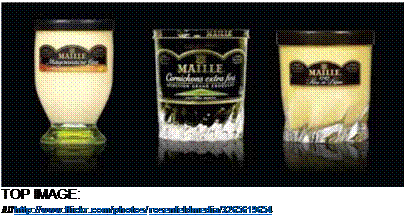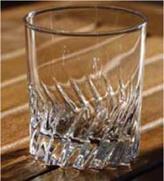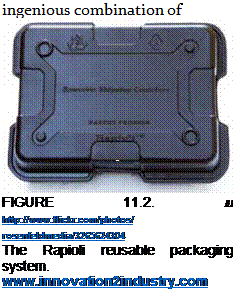Making a solution more durable is, in effect, a type of reuse, but this chapter is about extending past that type. Instead, designers should consider if and how they can transform a solution from once or short-term use to long-term use. Anything sold as “disposable” might better serve customers and sustainability alike if the solution incorporated a reusable context.
There are two types of reuse: deliberate and unintended reuse.
For example, a disposable one-use bag might be convenient, but a reusable bag (made from more durable materials) would be more sustainable over time. There may be a place for disposable diapers because of their convenience, but a scenario of reusable diapers that are laundered is likely more sustainable.
To be sure, not everything can or should be reused. Some medical equipment is designed specifically to be used only once and not to be cleaned. In fact, this is now the standard for syringes, needles, and many other medical devices. However, while dressings and bandages shouldn’t be reused, for years many medical products, like IV bags and needles, were cleaned, sterilized, and reused without any problems.
Anything sold as “disposable” might better serve customers and sustainability alike if the solution incorporated a reusable context.
Maille Condiments (continued)
 |
is as well known in France for its approach to reusing glass jars. The seal and cap are designed for easy removal after use, and the edges are already finished for use as drinking glasses. The company often releases special commemorative series, and the latest glasses are a surprisingly premium design.
 BOTTOM image:
BOTTOM image:
/Ш http://www. flickr. com/photos/ rosenfeldmedia/3265568292
FIGURE 11.1
Maille has been selling its condiments in reusable jars for decades. www. maille. com
In our current, throw-away society, there are precious few examples of purposefully designed reuse. In the 1940s and 1950, when conservation was de rigueur, this was more common. However, there’s no reason why more products, especially consumables like food, water, paper products, soaps, cleaners, and so on can’t be designed for reuse in other ways. Packaging is an especially good opportunity for product reuse.
One way to help products be more reusable is to make them easy to clean. Another way is to design them to separate easily from packaging or to use components that aren’t designed for reuse (for example, the lid of the Maille jars). Modularity and interchangeable parts improve product reusability, as do simplification and standardization of parts and components.
Energy, too, can be reused in innovative ways. For example, several years ago, lampshades for children’s rooms started appearing that used the heat coming from an incandescent bulb (for people still using those) to make the lampshade
turn around, simply from the convection of hot air rising through the vanes in the lampshade. The lampshade, then, became a spinning stencil for projecting light figures in a room, like a mirror ball with shapes.
Even though it’s nearly impossible for designers to plan for unintended reuse, designers can often develop solutions that recycle items in completely different ways. Technically, this is still recycling, so look at the example in Chapter 13 for William Good.
Rapioli™
Moving parts around the world is an important business function, but the packaging used to ship them is often discarded and never reused. To make a more sustainable solution, Ken Eskenazi created a brilliantly designed system, called Rapioli, with modular components that allow packaging to be reused over 100 times and easily stacked and stored (see Figure 11.2). Intended for the business-to-business market, the packaging
is made from only two reversible parts (the outer shell, and an inner cushion) that consist entirely of recycled PET plastic.
In addition to reducing waste, reusing excess PET, and reducing the need for paper, Rapioli also saves companies money on each shipment, compared to standard cardboard boxes. Material labels are molded into the packaging, along with flanges that snap the two shells together and nubs to aid stacking. There’s ample room for packing labels as well.
 In all, the solution’s material selection, industrial design, and market-
In all, the solution’s material selection, industrial design, and market-
appropriate economics makes it both more effective and more sustainable.
We’ve all heard about the need to recycle, but few of us do it to the extent that we could, and this causes a great deal more environmental impact than necessary. For example, in 2005 (the latest year for the EPA to report), U. S. citizens recycled about a third of what went into the municipal waste stream. That’s a steady improvement, but not a figure to be proud of, nor a sustainable strategy. The items with the best recycling rates included containers and packaging (roughly, 40 percent). In addition, approximately 60 percent of yard waste was recycled overall, although far less food waste. However, to temper all of these gains, the overall amount of trash is increasing rapidly. From 1980 to 2005, U. S. citizens generated more than double their amount of trash1 (see Figure 12.1)
Some communities already recycle at much higher rates. (San Francisco hit the new record
in April 2008 of 70 percent and is focused on improving even more.[60]) These efforts are important because they provide models for other communities to follow, at the governmental, citizen, NGO, and business levels. For example, San Francisco’s system involves tight coordination between the city and municipal waste collection, sorting, and recycling facilities. In addition, education and convenience for customers are critical to these high rates. There’s also a cultural force at work within the community that creates the desire and understanding of recycling.
|
CHAPTER 12




